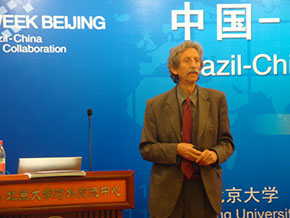

Brazilian group obtains structure from crystalline silicon with self-organized nickel nanoparticles on the surface; fabrication process was presented at FAPESP Week Beijing (photo: E.Alisson)
Brazilian group obtains structure from crystalline silicon with self-organized nickel nanoparticles on the surface; fabrication process was presented at FAPESP Week Beijing.
Brazilian group obtains structure from crystalline silicon with self-organized nickel nanoparticles on the surface; fabrication process was presented at FAPESP Week Beijing.

Brazilian group obtains structure from crystalline silicon with self-organized nickel nanoparticles on the surface; fabrication process was presented at FAPESP Week Beijing (photo: E.Alisson)
By Elton Alisson, in Beijing
Agência FAPESP – The process of self-organization in nature, in which molecules and complex structures form and adjust to the conditions of the biological systems into which they are introduced, have inspired researchers to develop ordered systems with metallic particles on a nanometric scale (billionths of a meter), based on the same principle.
One example of this is a structure obtained from silicon with self-organized nickel nanoparticles deposited on its surface, which has just been developed by researchers at the Gleb Wataghin Physics Institute (IFGW) of the University of Campinas (Unicamp).
A result of the thematic project “Research and development of nanostructured materials for electronic and surface physics applications”, the process of creating the structure has been described in a paper accepted for publication in the Journal of Physics D: Applied Physics, and was presented on April 16 during FAPESP Week Beijing – Brazil-China Scientific Collaboration in Beijing, China.
The event, jointly promoted by FAPESP and Peking University (PKU) and holding sessions through April 18 in the Chinese capital, brings together researchers from the two countries to discuss studies in the fields of materials science, the environment, renewable energy, agriculture, life sciences, medicine and health, in the interest of developing scientific collaboration.
“Self-organized nickel nanoparticles on well-defined surfaces can have a wide range of applications,” said Fernando Alvarez, professor at IFGW and coordinator of the project, in comments to Agência FAPESP.
“This area of research has awakened a great deal of interest because it could reduce costs and cut the number of stages needed to fabricate nonostructured materials with potential magnetic, optical and catalytic properties, with applications in the microelectronics industry and nanotechnology,” Alvarez asserted.
According to Alvarez, techniques such as photolithography and electron lithography are used to obtain this type of nanostructured material.
These techniques, however, involve a number of stages to reach completion, and they are time-consuming and costly. Consequently, there is interest in finding new avenues for simplifying the processes of obtaining nanostructured materials.
Alvarez says that one promising approach that has come to light in recent years is the nanostructuring of substrates by means of ion bombardment.
Using this technique, it is possible to obtain regular shapes on metals, semiconductors and amorphous materials that can be used as a template for growing self-organized structures.
“Ion bombardment basically makes it possible to shape a substrate so that, when atoms or molecules are deposited onto it, the particles are forced to self-organize on the surface of the material according to its surface topology,” Alvarez explained.
Fabrication process
To develop materials with these characteristics, the researchers in Alvarez’s group at IFGW bombarded a crystalline silicon substrate with heavy-atom ions of noble gases such as krypton, xenon and argon. The bombardment creates undulations on the substrate and causes its surface to display well-defined periodic shapes, such as groove-like parallel lines, for example, according to Alvarez.
When nickel atoms are deposited onto the material through a process known as ion beam cathode pulverization, the atoms seek out proper accommodation on the periodic shapes that exist on the surface of the structure. This creates a material with a well-defined two-dimensional structure, Alvarez notes.
“Due to the defined periodic shapes on the substrate, when thermally excited nickel atoms land on it, they move along the surface of the structure until they encounter other atoms and nucleate,” he explained.
“As a result, particles or agglomerates are formed on the surface of the material with well-defined periodic arrangements,” the researcher said.
According to Alvarez, each particle formed by the metal atoms on the surface of the crystalline silicon substrate can be used, for example, as a magnetic point with possible applications in microelectronics.
The particles can also catalyze (initiate) the growth of carbon nanotubes—materials that require nickel or other types of metallic particles to promote their growth.
“By developing a template of small, uniformly-distributed particles and forming a periodic structure on the surface of a substrate, it is possible to deposit carbon particles on this material, and they will grow and form nanotubes according to the prefabricated shape of the material,” he said.
According to Alvarez, these potential applications, however, are still on a laboratory scale.
“We are demonstrating the possibility of developing materials and processes for these applications,” Alvarez said. “But in order to fabricate them we need engineering laboratories with much more complex equipment than we have now, and it would require making a number of adjustments in order to form periodic structures with a minimum number of defects,” he noted.
Republish
The Agency FAPESP licenses news via Creative Commons (CC-BY-NC-ND) so that they can be republished free of charge and in a simple way by other digital or printed vehicles. Agência FAPESP must be credited as the source of the content being republished and the name of the reporter (if any) must be attributed. Using the HMTL button below allows compliance with these rules, detailed in Digital Republishing Policy FAPESP.





